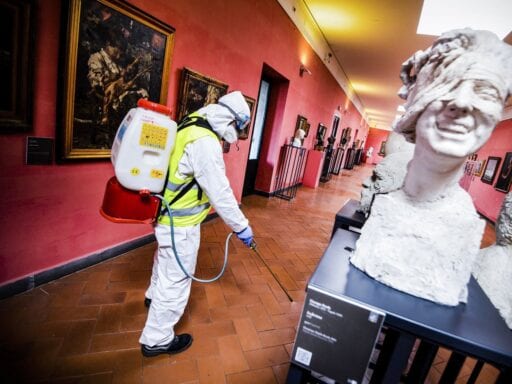Italy is under quarantine and more.
As of March 10, there are more than 116,000 cases of the novel coronavirus around the world. More than 4,200 people have died so far. In China, President Xi Jinping made a very public visit to Wuhan, the epicenter of the outbreak, to signal the virus is under control, even as the coronavirus crisis grew elsewhere.
In Italy, all 60 million people in the country are under stringent travel restrictions. In the United States, where the number of cases has risen past 700, state and local officials are beginning to declare emergencies, shut schools, and encourage “social distancing” — yes, somehow even on the New York City subway.
The coronavirus news is nonstop, but here’s what you need to know today.
Italy in quarantine
All of Italy went on lockdown Monday evening, the first day of a new order that severely restricts travel for the country’s 60 million people. The unprecedented peacetime decree, dubbed “I Stay Home,” is Italy’s desperate attempt to try to slow the spread of the country’s coronavirus outbreak that’s now surpassed 9,000 cases.
/cdn.vox-cdn.com/uploads/chorus_asset/file/19782449/GettyImages_1206462185.jpg) Matteo Nardone/LightRocket via Getty Images
Matteo Nardone/LightRocket via Getty ImagesTravel is strictly limited to essential activities such as work, family reasons, and runs for food or supplies. To make those trips, people must get permission from authorities. Public events are suspended: no weddings, funerals, concerts, movies, or sporting events. Schools are shut. Jail visits have been halted.
These measures will remain in effect until April 3. “The right decision today is to stay at home. Our future and the future of Italy is in our hands,” Prime Minister Giuseppe Conte said. “These hands have to be more responsible today than ever before.”
The White House contemplates economic relief amid criticism over the administration’s response to the outbreak
President Donald Trump has floated a few potential policies to give individuals and businesses an economic reprieve during the uncertainty of coronavirus: a payroll tax cut, relief for hourly workers, and bailout packages for airlines, cruise ships, and other travel-related industries hit hard by the outbreak.
The big question is whether Congress will support these measures. The president is headed to Capitol Hill for lunch on Tuesday to try to persuade Senate Republicans, who are wary about a payroll tax cut, according to the Washington Post. Democrats are hoping to use the moment to push through paid sick leave, including coverage for workers forced to quarantine because of the coronavirus or to care for kids who can’t go to school because of shutdowns.
/cdn.vox-cdn.com/uploads/chorus_asset/file/19782465/GettyImages_1206458605.jpg) Brendan Smialowski/AFP via Getty Images
Brendan Smialowski/AFP via Getty ImagesThe full economic impact of the coronavirus outbreak in the United States and elsewhere is still revealing itself. Wall Street is going haywire, with an oil price war compounding fears of an economic slowdown. The travel and tourism industries — airlines, cruises, hotels, and more — are getting hit hard. If the coronavirus continues to spread in the US, more and more people will have to self-quarantine, creating ripple effects across industries and putting financial strain on individuals.
At the same time, some are worried that Trump’s obsession with the economy is distracting from the most urgent public health problem: simply trying to mitigate the spread of the coronavirus, particularly to vulnerable communities.
The United States is still only conducting a limited number of tests for the virus, according to a recent report in the Atlantic. That likely means the US is undercounting the number of coronavirus cases, which makes it harder to track its spread and to protect communities.
Secretary of Health and Human Services Alex Azar said on Monday that nearly 4 million tests would be available by the end of the week in the US. But many health experts think delays from the Centers for Disease Control and Prevention in providing adequate testing have hampered public health officials’ ability to control the disease.
Researchers say the novel coronavirus has a median five-day incubation period
There’s still a lot scientists and clinicians don’t know about the coronavirus, which makes preparing and preventing its spread so difficult. But a new study published in the Annals of Internal Medicine might back up public health officials’ recommendation of a 14-day quarantine on those exposed to the virus.
The study found that the median incubation period of the disease — that is, the time between when a person is exposed to the virus and when symptoms start to present — is five days.
/cdn.vox-cdn.com/uploads/chorus_asset/file/19782483/GettyImages_1206462258.jpg) NurPhoto via Getty Images
NurPhoto via Getty ImagesThe study found that the incubation period can vary widely on both sides of that median, but that 98 percent of people who develop symptoms do so in about 11.5 days. There were some exceptions of symptoms taking longer to develop, but in the majority of cases, the authors say, a 14-day quarantine and monitoring is “reasonable.”
The researchers looked at 181 coronavirus cases in China and elsewhere before February 24 for this study. Researchers will likely continue examining the virus as more cases develop, and as it spreads. But for now, the bottom line seems to be: If you’ve been exposed to the coronavirus, please, please follow the CDC’s instructions and self-quarantine for 14 days.
Author: Jen Kirby
Read More



